Restored Hasegawa/Aeroclub Spitfire VIII
Going through things in storage here at the house, I've come across some models. Over the years, they got dinged in storage, but they were good models, worth restoring. This is from 2006. A Hasegawa Spitfire VIII with the Aeroclub drop-fit corrected fuselage, decals from Victory Productions Decals "Spifire: Aces of the Empire."
Restored with replacement main landing gear from Eduard spare parts box, ditto for the windscreen and canopy. A coat of clear gloss after a good wash to restore the paint, a coat of clear flat to finish it.
Before there was the Eduard Spitfires, this was as close as you could get to a good Merlin-60 series Spitfire.
Here's from the review at Modeling Madness 16 years ago:
Robert Gibbes:
Robert Henry Maxwell Gibbes joined the Royal Australian Air Force as an Air Cadet in February 1940. By 1941, he was a Pilot Officer. He first served overseas as Adjutant with 450 Squadron that year. He flew first the Curtiss Tomahawk and later the Kittyhawk in North Africa. He was promoted to Acting Squadron Leader of 450 in February 1942, at which point he was transferred to 3 Squadron as Squadron Leader. On May 26, 1942, he was shot down in flames, and parachuted at low altitude, breaking his leg and ankle. In July 1942, while making a low-level strafing attack at Nun, Tripolitania, he landed in enemy territory and picked up a Pilot Officer of his squadron who had been shot down by flak. He saw combat against both the Germans and the Italians, scoring 10 victories in North Africa, and one against the French while participating in the invasion of Vichy-controlled Lebanon in 1941, making him the 14th-ranked ace of the RAAF in World War II.
In 1944, he returned to Australia, where he became Chief Flying Instructor at Mildura that March. Promoted to Temporary Wing Commander, he was first posted to 80 Wing at Darwin that as Deputy Wing Commander, then led the unit to the Halmaheras in October. He remained as Wing Commander (Flying) until the ill-fated “Revolt of the Wing Leaders” in the Spring of 1945.
The Revolt of the Wing Leaders or “The Morotai Mutiny”:
By early 1945, the RAAF First Tactical Air Force (TAF) was based at Morotai, where the Spitfires of 80 Wing were tasked with providing fighter cover for the Beaufighter wing and the Kittyhawk fighter-bomber wing. Their task was to free the southern Philippines, Netherlands East Indies and British Borneo of Japanese forces as part of the overall Montclair Plan. This was overtly political, as the Australian government was already looking forward to an expanded regional role for the country post-war. Prior to the landing at Tarakan in Operation Oboe in May 1945, operations mainly involved strafing ground targets and watercraft, and some dive-bombing. While there were few enemy aircraft, enemy anti-aircraft defenses were active and a number of aircraft were shot down. There was a certain amount of grumbling among the units over these losses, since the “real war” was in the north in the Philippines and on to Okinawa, and these areas were seen as places that the Japanese would surrender regardless once the war was over. Aircrew deaths and other losses were seen as pointless in the overall situation.
Group Captain Wilfred Stanley “Wilf” Arthur, who at age 24 was the youngest Group Captain in the RAAF following a distinguished combat career with 3 Squadron in North Africa and 75 Squadron in New Guinea, was OC 81 Wing with Kittyhawk IVs in the Spring of 1945. As he later put it, “There were occasions previously when certain things that had been done by the RAAF had disappointed and probably disgusted me, but I finally sold out ... about the time I was at Morotai. I thought there was very little hope left for the RAAF.” He went on to explain that by "selling out", he meant: “What I considered the complete dishonesty of purpose evident in First TAF and the fact that I considered there was no attempt being made to kill Japanese, and that the only reason for most of the activities of First TAF was personal benefit of individuals within the Air Force. I considered there were certain persons using the Air Force for their own personal advantage and in the Air Force, it means peoples' lives. I reckoned it was and I reckon it is treason. It is also my opinion from what I have seen before that it is not peculiar to First TAF; that it exists in all the Air Force. We were wasting time, endangering peoples' lives and wasting valuable bombs and ammunition."
Arthur asked his Intelligence Officer to put together a “Balance Sheet” for his Wing's operations and took this took this to Air Commodore Cobby, the Air Officer Commanding, where it was ignored. Arthur initially discussed his balance sheet with Group Captain Gerald Packer who was the Senior Officer Administrative of 1st TAF. Packer considered the document had merit, and told Arthur to take it direct to AOC Cobby. Encouraged by Packer, Arthur took the paper to Cobby on January 23, 1945. Arthur showed Cobby his figures and explained why he thought the operations were not worthwhile. Cobby looked at the figures and said they were interesting and asked for copies of the balance sheet, relevant operational instructions and the intelligence appreciations.
Arthur was disappointed that no official attention was given after this and concluded that, because no action was taken, there was something dishonest in the way 1st TAF in particular - and the RAAF in general - were prosecuting the war. He brought these matters up to the leaders of the other units in 1st TAF, who agreed with him. On April 20, 1945, Group Captain Wilfred Arthur, Group Captain Clive Caldwell, Wing Commander Kenneth Ranger, Wing Commander Robert Gibbes, Squadron Leader John Waddy, Squadron Leader Bert Grace, Squadron Leader Douglas Vanderfield and Squadron Leader Stuart Harpham applied for permission to resign from the RAAF, on the grounds their service was wasted in these operations. All indicated a strong willingness to take 1st TAF to the Philippines or Okinawa to enter combat on the front lines of the Pacific War.
These men were some of the most famous names and genuine heroes in the wartime RAAF, and the Australian government could ill afford the adverse publicity of their complaint becoming known within the country, since Australians in general had (and still have) a strong opposition to the needless waste of men in war stemming from their experience as cannon fodder for the British at Gallipoli in the First World War. There was a fear on the part of the government that it could fall if this became public.
An Inquiry was held to investigate the resignations, conducted by John Vincent William Barry KC. The government was considering bringing charges of mutiny in wartime and resignation in wartime, which are very serious charges indeed.
Arthur stated that, after he arrived at Morotai, he decided he would not take part in operations he thought were worthless. He was then asked "This gets very close to Mutiny, does it not?" He responded "Yes. I meant to make as big a fuss as I possibly could with the object of getting the position corrected... we thought that, in the end, if we put our cards on the table, we would have a sufficiently strong case to prejudice a lot of people in our favor. All the same, we realized that, to lay ourselves open to any charge of mutiny, we might lessen the force of what we were doing, which was the reason we put the things in as resignations and not as any attempt to unseat people higher up ... It occurred to us, but we did not seriously think, or I did not, anyhow, that we would be charged with mutiny.”
The Commissioner of the Inquiry determined that the eight had no real intentions towards mutiny, and he did not comment on the potentially mutinous actions in his report. However, the government was not prepared to forgive and forget this affront to their authority.
There is no provision for officers to resign their commissions in time of war. "Except during time of war and except as otherwise prescribed, an officer may by writing under his hand tender the resignation of his commission at any time by giving three months notice." Flight Lieutenant Davoren, who represented Caldwell, argued that “There is no provision that prohibits your requesting permission, nor is there any requirement that when you make such a request, the grounds of your application must be stated."
In the end, while these serious charges were dropped, each and every one of these officers was found - after a very detailed investigation - to have committed many small variances in the conduct of paperwork and the enforcement of petty regulations such as allowing access to liquor at forward bases, and each was demoted one grade for allegedly having profited in a scheme to provide alcohol to their men. All left the RAAF in the year following the end of the war, though each had been seen before this event as having a spectacular future in the air force.
After leaving the RAAF, Robert Gibbes established Gibbes Sepik Airways Ltd. in 1948, operating throughout New Guinea during the 1950s through the 1970s.
The Model:
Hasegawa's Merlin-60 series Spitfire has been praised and damned since its release in 2001. The level of detail is marvelous, the cockpit is so good one does not need to even think of replacing it with a resin “correction set.” Unfortunately, the fuselage - which was designed using a set of incorrect drawings - is significantly misshapen, being too short overall and with other serious dimensional irregularities. The kit makes up into a beautiful model, but for anyone who really loves the Spitfire, that fuselage makes things look “odd,” to say the least.
Loon Models released a resin “corrected fuselage” a few years ago which did answer the problem of overall length, but did not deal with the other dimensional problems of the fuselage, and was at least as expensive as the original kit.
We now have a solution from John Adams at Aeroclub that is both accurate overall and inexpensive to obtain. The Aeroclub fuselage, which was released this past September, corrects all the dimensional problems associated with the Hasegawa kit's fuselage, as a “drop fit conversion.” While this is a limited-run product and is thicker than the Hasegawa parts, special effort was made to keep the area of the cockpit as thin as the original kit parts, so that the detail parts of the kit fit as they would with the regular fuselage. The correction set includes a lower forward fuselage with either the early or late intake.
There is still an “issue” with the Aeroclub set, as the Spit Boffin's Spit Boffin, my good friend Bruce Archer, has pointed out. This is that the entire cockpit interior is 1mm too far forward. I have to say that when I read this from him, and looked at my completed kit, my reaction was “huh?” Personally, I can't even see 1mm on a ruler, so this doesn't rock my boat. Those who do worry about this can move the various bulkheads back, but this will then throw out alignment with the molded-in sidewall detail. For me, it's a glitch I can live with.
I also used the Red Roo conversion set for the Spitfire VIII, which provides a more accurate set of long-barrel cannons than are in the kit, and a corrected tailwheel and gear doors, as well as a rudder with less-overdone surface detail and a superior shape.
I will note here that Red Roo also does corrected fuselages for the Spitfire VIII and Spitfire IX that completely replace all the fuselage parts of the original kit other than the cockpit detail. I haven't seen these myself, but based on the past Red Roo products I have been happy to use, I am certain these are also worth getting.

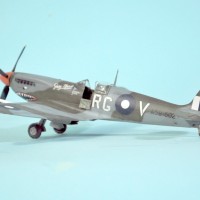
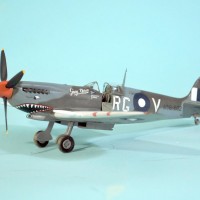
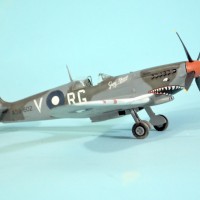
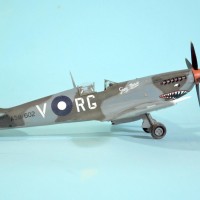
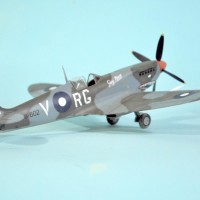
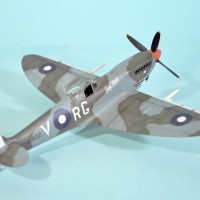
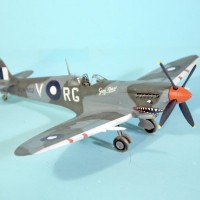
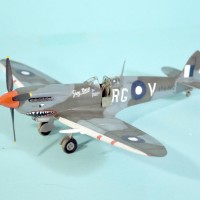
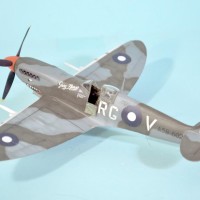
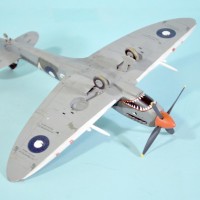
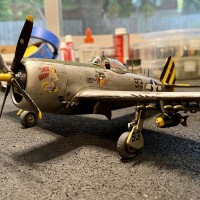
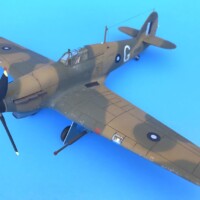


Excellent model, excellent review, excellent restoration, Tom.
I remember the October 2006 review: those were the days!
Nice resurrection, Tom.
Looks great!
I remember this one from MM. Glad to see it’s been spiffed up!
Great model and great story. This is a bit of history that I never heard before. Once again, the politicians were killing the "troops" for greed and not for tactical/strategic goals. Though not as dangerous to me personally, It reminds me of when I was bombing "suspected" jungle in Cambodia in 1973.
Actually, it was "strategic." The Australian government was looking to the post-war, when they were going to have "influence" in the area of Asia near Australia - the whole thing was "politics."
Still looks good Tom despite the passing years!
Fine result, Tom. All good.
Nice Tom! The Spitfire isn't my favorite subject (don't call me an infidel!) but I really like this scheme - S. Pacific, right? I'm going to have to do one of these...
Very nice once more, Tom @tcinla
Not often seen a Spitfire with a sharkmouth.
Great article as well, loved to read it.
Nice recovery. Gibbs was quite a character.